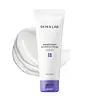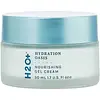What's inside
What's inside
 Key Ingredients
Key Ingredients

No key ingredients
 Benefits
Benefits

 Concerns
Concerns

 Ingredients Side-by-side
Ingredients Side-by-side

Water
Skin ConditioningGlycerin
HumectantButylene Glycol
HumectantCetyl Ethylhexanoate
EmollientCyclopentasiloxane
EmollientHydrogenated Poly(C6-14 Olefin)
EmollientPentaerythrityl Tetraethylhexanoate
EmollientDimethicone
EmollientSqualane
Emollient1,2-Hexanediol
Skin ConditioningPolyglyceryl-3 Methylglucose Distearate
EmulsifyingPentylene Glycol
Skin ConditioningGlyceryl Stearate
EmollientHydrogenated Vegetable Oil
EmollientPanthenol
Skin ConditioningStearyl Alcohol
EmollientArachidyl Alcohol
EmollientCetyl Alcohol
EmollientCetearyl Alcohol
EmollientPolymethylsilsesquioxane
Behenyl Alcohol
EmollientHydroxyethyl Acrylate/Sodium Acryloyldimethyl Taurate Copolymer
Emulsion StabilisingMannitol
HumectantGlyceryl Arachidonate
EmollientGlyceryl Linoleate
EmollientGlyceryl Linolenate
EmollientArachidyl Glucoside
EmulsifyingCopernicia Cerifera Wax
Cetearyl Glucoside
EmulsifyingEthylhexylglycerin
Skin ConditioningDipotassium Glycyrrhizate
HumectantHydrogenated Olive Oil Lauryl Esters
Emulsion StabilisingSerine
MaskingXanthan Gum
EmulsifyingGlycine
BufferingLecithin
EmollientSodium Phytate
Arginine
MaskingWater, Glycerin, Butylene Glycol, Cetyl Ethylhexanoate, Cyclopentasiloxane, Hydrogenated Poly(C6-14 Olefin), Pentaerythrityl Tetraethylhexanoate, Dimethicone, Squalane, 1,2-Hexanediol, Polyglyceryl-3 Methylglucose Distearate, Pentylene Glycol, Glyceryl Stearate, Hydrogenated Vegetable Oil, Panthenol, Stearyl Alcohol, Arachidyl Alcohol, Cetyl Alcohol, Cetearyl Alcohol, Polymethylsilsesquioxane, Behenyl Alcohol, Hydroxyethyl Acrylate/Sodium Acryloyldimethyl Taurate Copolymer, Mannitol, Glyceryl Arachidonate, Glyceryl Linoleate, Glyceryl Linolenate, Arachidyl Glucoside, Copernicia Cerifera Wax, Cetearyl Glucoside, Ethylhexylglycerin, Dipotassium Glycyrrhizate, Hydrogenated Olive Oil Lauryl Esters, Serine, Xanthan Gum, Glycine, Lecithin, Sodium Phytate, Arginine
Water
Skin ConditioningGlycerin
HumectantSqualane
EmollientButylene Glycol
HumectantDiglycerin
HumectantDiphenylsiloxy Phenyl Trimethicone
Skin ConditioningHydrogenated Lecithin
EmulsifyingBehenyl Alcohol
EmollientCetyl Alcohol
EmollientDimethicone
EmollientHydrolyzed Sodium Hyaluronate
Skin ConditioningTrehalose
HumectantCryptomeria Japonica Bud Extract
Skin ConditioningAlanine
MaskingArginine
MaskingGlycine
BufferingSerine
MaskingGlycolipids
Skin ConditioningThreonine
Malus Domestica Fruit Cell Culture Extract
Skin ConditioningChamomilla Recutita Flower Extract
MaskingCarbomer
Emulsion StabilisingHydroxyacetophenone
AntioxidantPotassium Hydroxide
BufferingXanthan Gum
EmulsifyingLecithin
EmollientPhenoxyethanol
PreservativeParfum
MaskingLinalool
PerfumingBenzyl Salicylate
PerfumingCI 42090
Cosmetic ColorantWater, Glycerin, Squalane, Butylene Glycol, Diglycerin, Diphenylsiloxy Phenyl Trimethicone, Hydrogenated Lecithin, Behenyl Alcohol, Cetyl Alcohol, Dimethicone, Hydrolyzed Sodium Hyaluronate, Trehalose, Cryptomeria Japonica Bud Extract, Alanine, Arginine, Glycine, Serine, Glycolipids, Threonine, Malus Domestica Fruit Cell Culture Extract, Chamomilla Recutita Flower Extract, Carbomer, Hydroxyacetophenone, Potassium Hydroxide, Xanthan Gum, Lecithin, Phenoxyethanol, Parfum, Linalool, Benzyl Salicylate, CI 42090
Ingredients Explained
These ingredients are found in both products.
Ingredients higher up in an ingredient list are typically present in a larger amount.
Arginine is an amino acid that is important for human development. Your body uses is it to produce hair keratin and skin collagen.
As a cosmetic ingredient, Arginine has antioxidant properties and can also help repair damaged skin. This ingredient is derived either synthetically or from animals.
Arginine isn't fungal acne safe when used in the presence of other lipids (fats, fatty acids, oils, esters, etc). Oils and fats occur naturally within the skin, so take caution when using Arginine if you're prone to fungal acne.
Learn more about ArginineBehenyl Alcohol is a type of fatty alcohol (these are different from the drying, solvent alcohols).
Fatty Alcohols have hydrating properties and are most often used as an emollient or to thicken a product. They are usually derived from natural fats and oils; behenyl alcohol is derived from the fats of vegetable oils.
Emollients help keep your skin soft and hydrated by creating a film that traps moisture in.
In 2000, Behenyl Alcohol was approved by the US as medicine to reduce the duration of cold sores.
Learn more about Behenyl AlcoholButylene Glycol (or BG) is used within cosmetic products for a few different reasons:
Overall, Butylene Glycol is a safe and well-rounded ingredient that works well with other ingredients.
Though this ingredient works well with most skin types, some people with sensitive skin may experience a reaction such as allergic rashes, closed comedones, or itchiness.
Learn more about Butylene GlycolCetyl Alcohol is a fatty alcohol. Fatty Alcohols are most often used as an emollient or to thicken a product.
Its main roles are:
Though it has "alcohol" in the name, it is not related to denatured alcohol or ethyl alcohol.
The FDA allows products labeled "alcohol-free" to have fatty alcohols.
Learn more about Cetyl AlcoholDimethicone is a type of synthetic silicone created from natural materials such as quartz.
What it does:
Dimethicone comes in different viscosities:
Depending on the viscosity, dimethicone has different properties.
Ingredients lists don't always show which type is used, so we recommend reaching out to the brand if you have questions about the viscosity.
This ingredient is unlikely to cause irritation because it does not get absorbed into skin. However, people with silicone allergies should be careful about using this ingredient.
Note: Dimethicone may contribute to pilling. This is because it is not oil or water soluble, so pilling may occur when layered with products. When mixed with heavy oils in a formula, the outcome is also quite greasy.
Learn more about DimethiconeGlycerin is already naturally found in your skin. It helps moisturize and protect your skin.
A study from 2016 found glycerin to be more effective as a humectant than AHAs and hyaluronic acid.
As a humectant, it helps the skin stay hydrated by pulling moisture to your skin. The low molecular weight of glycerin allows it to pull moisture into the deeper layers of your skin.
Hydrated skin improves your skin barrier; Your skin barrier helps protect against irritants and bacteria.
Glycerin has also been found to have antimicrobial and antiviral properties. Due to these properties, glycerin is often used in wound and burn treatments.
In cosmetics, glycerin is usually derived from plants such as soybean or palm. However, it can also be sourced from animals, such as tallow or animal fat.
This ingredient is organic, colorless, odorless, and non-toxic.
Glycerin is the name for this ingredient in American English. British English uses Glycerol/Glycerine.
Learn more about GlycerinThis ingredient is an amino acid that helps build proteins and moisturizes skin. It is already present in our skin as our bodies produce them naturally.
Glycine already plays a role in helping keep our skin moisturized as amino acids transport moisture throughout our skin.
As collagen is made up of glycine and other amino acids, it is believed glycine may help our skin produce more collagen.
Learn more about GlycineLecithin is a term for a group of substances found in the cell membranes of plants, animals, and humans. They are made up of mixture of phospholipids.
This ingredient has emollient and emulsifying properties.
As an emollient, lecithen helps soften the skin and creates a barrier to keep moisture in.
As an emulsifier, it also helps prevent water and oil ingredients from separating. Lecithin can also help ingredients be better absorbed by the skin.
This is because the phospholipids in lecithin produce liposomes. Liposomes help other ingredients get through the skin barrier.
Depending on the source of this ingredient, lecithin may not be fungal acne safe. This is because some sources of lecithin come from soybean oil, which may feed the malassezia yeast that feeds fungal acne.
We recommend reaching out to the brand you are purchasing from to inquire about the source of their lecithin.
Some other names for this ingredient include soy lecithin and deoiled soy lecithin.
Learn more about LecithinSerine is an amino acid naturally found in our body. Our bodies use amino acids to create protein.
Amino-acids help give keep our skin hydrated. They play an important role in the skin barrier, which keeps the skin plump and firm.
Serine is a non-essential amino acid, meaning we don't need to obtain it from eating foods.
Learn more about SerineSqualane is an emollient that helps the skin hold onto moisture. It's an oily liquid that occurs naturally in certain types of fish and plant oils.
Because squalane boosts hydration in the skin, it also comes with plenty of benefits: it is an antioxidant and can help fight free radicals and skin damage. Squalane is also found to have a detoxifying effect when applied.
Squalane comes from squalene, which occurs naturally within the sebum of our skin. It is one of the oils our skin produces to keep itself hydrated. Squalane is the hydrogenated version of squalene and has a longer shelf life.
Research shows that squalane is non-irritating (even at 100% concentration).
In general, it's a fantastic ingredient. It does a great job at hydrating the skin, and it's suitable for those with sensitive skin.
The source of squalane may impact malassezia / fungal acne. This is because olive oil derived squalane can contain impurities such as fatty acids and plant waxes. Sugarcane derived squalane is recommended for anyone with malassezia concerns.
Is squalane vegan?
This depends on the source. Squalane can be derived from both plants and animals. Most squalane used in skincare comes from plants.
Please note: the source of squalane is only known if disclosed by the brand. We recommend reaching out to the brand if you have any questions about their squalane.
Read more about squalene with an "e".
Is squalane an oil?
Squalane is often called an oil, but it’s technically not; it’s a hydrocarbon, meaning it’s only made of carbon and hydrogen, unlike true oils which are triglycerides made of fatty acids and glycerol.
The term “oil-free” isn’t regulated, so companies can define it however they want. Some exclude all oils, while others just avoid mineral oil or comedogenic oils.
While some people avoid oils thinking they cause breakouts, the right kind of oil (or oil-like ingredient like squalane) can actually help balance and hydrate your skin. It’s worth testing out simple oils or squalane to see what works best for your skin.
Learn more about SqualaneWater. It's the most common cosmetic ingredient of all. You'll usually see it at the top of ingredient lists, meaning that it makes up the largest part of the product.
So why is it so popular? Water most often acts as a solvent - this means that it helps dissolve other ingredients into the formulation.
You'll also recognize water as that liquid we all need to stay alive. If you see this, drink a glass of water. Stay hydrated!
Learn more about WaterXanthan gum is used as a stabilizer and thickener within cosmetic products. It helps give products a sticky, thick feeling - preventing them from being too runny.
On the technical side of things, xanthan gum is a polysaccharide - a combination consisting of multiple sugar molecules bonded together.
Xanthan gum is a pretty common and great ingredient. It is a natural, non-toxic, non-irritating ingredient that is also commonly used in food products.
Learn more about Xanthan Gum